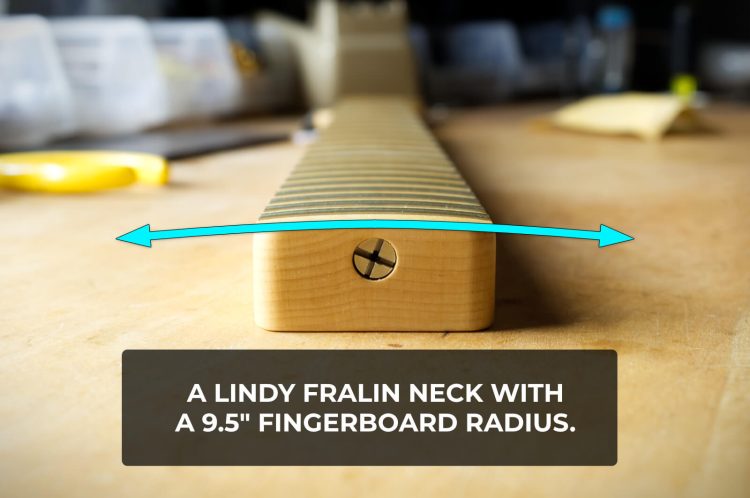Convert Your Tele Neck Into a 3-Wire Neck
Due to the popularity of 4-Way Switching, we get asked a lot about converting a Telecaster Neck Pickup into a 3-Wire Neck. In today’s lesson, we’ll show you how to […]


One question we answer frequently is about Fingerboard Radius. It can be a determining factor when purchasing pickups that allow you to choose an option for Magnet Stagger. This topic can seem confusing but is pretty simple to understand. Knowing the radius of your fingerboard enables you to optimize your pickups by selecting the best stagger for your pickups. Let’s dig in!
When purchasing or building an instrument, you will find a specification for “Fingerboard Radius.” This specification might present 7.25″, 9.5″ or ‘Compound Radius’ values. What is does this specification mean for you, and what do these values mean for your pickups?
A Fingerboard Radius measures the curvature across the guitar’s fingerboard, from your low string to your high string. It’s easy to confuse this measurement with your neck’s “bow”, adjusted by a truss rod, but Fingerboard Radius is much different.

When describing the radius of your fingerboard, you will see values ranging from 7.25 inches to 14 inches to “Compound.” The smaller the value, the more curved your fingerboard is. The higher the value, the flatter your fingerboard is. Vintage Fender instruments have rounder fingerboard radiuses (7.25″) while more modern Fenders feature a 9.5″ radius. At the same time, Gibson and a lot of modern instruments come standard with flatter radiuses (12″+).
The values of your neck’s radius has a significant impact on how your instrument feels and plays. For example, players find it more comfortable to play chords with a slightly rounder radius on a fingerboard. In contrast, others prefer flatter fingerboard radiuses when playing single notes, bending, and tapping their fingerboards.
Lately, we’ve seen an uptick in guitars with a “Compound Radius.” A Compound Radius starts round and flattens as you move up the neck. For example, the low frets might be 9.5 inches, and the 12th fret and beyond flattens to 14 inches. Compound Radiuses offer the comfort of a rounder radius in the typical “chord” zone of the fingerboard, while flattening in the “solo” zone of the fingerboard.
There are a few ways to identify the radius of your instrument’s fingerboard:
Our traditional Stratocaster and Telecaster pickups have an option for selecting “Magnet Stagger”.
It’s essential to understand and identify your guitar’s Fingerboard Radius before determining Magnet Stagger. Magnet Stagger is the pattern of magnet or pole piece height under each string. We have different pickup staggers optimized for different fingerboard radiuses: a “Stock” stagger for rounder radiuses (7.25″ – 9.5″) and a “Hybrid” stagger for flatter and compound radiuses (10″+). Each stagger optimizes the string-to-string balance of the pickup. See below for a comparison of our Magnet Staggers:


Selecting the optimized stagger for your instrument is simple!
In addition to “Magnet Stagger,” you might see “Pickup Radius” on our website. Pickup Radius is reserved for Split Blades and allows you to select the curvature of the Blades to match your fingerboard radius. We have three options:
3 Comments For This Post
Want to chime in to the conversation? Please do so! Please respect others.
Remember the big overall picture, we dont want to constipate the generated ac signal internally so we minimize those electrical constipating properties? Inductance Capacitance Resistance AnymoreProperties? Hysterisis? Both statically & dynamically electrical properties fluctuate and more so with frequency – the highs are easily constipated
I have experienced the opposite that pole magnet staggers should NOT follow neck radius slavishly. Only if you use flatwound string with a spun third, which most people don’t use today, but yet still, single coiled pickups are radiused for. Which beats me. Since the common use of plain G-string its dynamic attach always overwhelmes the output of all other strings especially the the neighboring D-string, and the high e-string seems always too weak in output in comparison/balance to all the other strings. Rail/Blade pickups are the same since you cant adjust them.
I would rather have the G&L adjustable polepieces where it matters the most. You can/must have the g-string pole piece as far down as possible, flush with the plastic shell, if not even below it. I wish one could adjust the stagger by myself. The neck radius has very little to do with the magnetic output of different strings. The pole pieces that should be the tallest is for high e-string and the d-string (which it is today on the d-string). The g-string always sticks out like a sore thumb.
Especially the bridge pickups which are slanted anyway towards that making the high e-string as weak as possible as it pick ups its vibrations closest to the bridge, to make use of high end treble (someone says shrill ice pick attack) but lowest in volume, the actual magnet stagger of any pickup there makes very little sense. If not totally moot and futile even.
I’m considering replacing my bridge fender telecaster pickup, currently a tex mex, with a Fralin blues special.
My current neck pickup is a DiMarzio true velvet. I’m wanting to know if there would be any problems combing the two and their compatibility.
Thanking You.